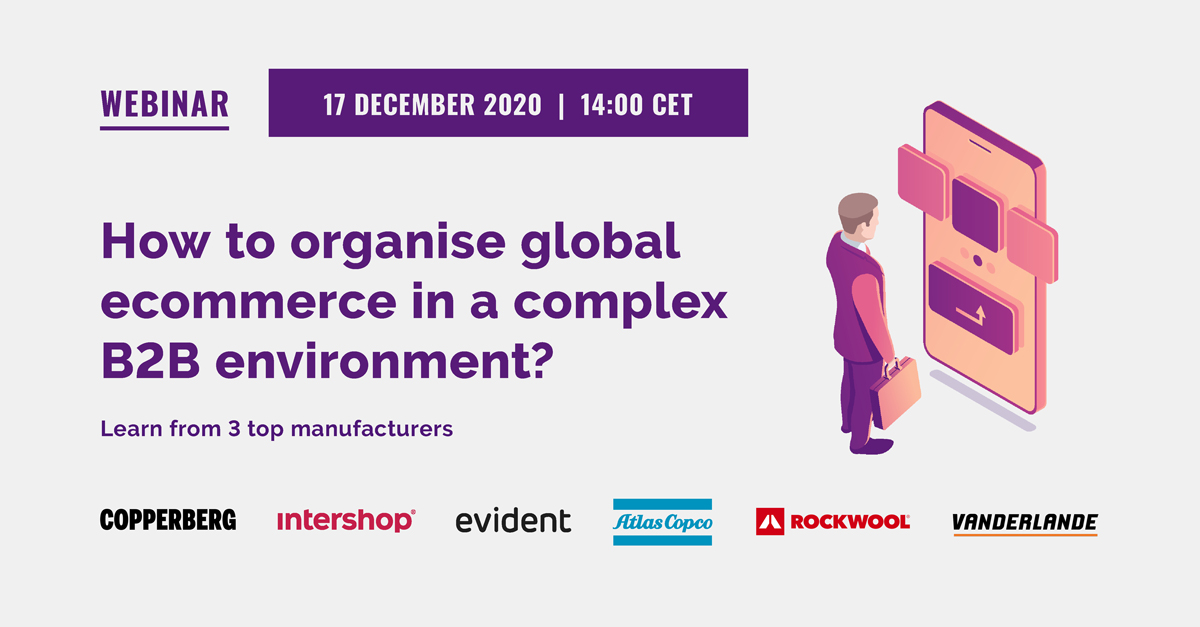B2B eCommerce is experiencing a new reality that many businesses are still adjusting to. Although the COVID-19 pandemic is far from over and continues to create uncertainty, more and more businesses are confident in the opportunities provided by digitally-enabled sales interactions.
Author Radiana Pit | Copperberg

And with traditional sales interactions expected to drop even after physical stores reopen, B2B sellers are considering an important next step to flourish and prosper in the new normal: going global and expanding their businesses into new countries.
The impact of COVID-19 on B2B eCommerce
A decent amount of B2B sellers were already on their path to digital transformation when the pandemic began. In and of itself, that journey comes with its own unique set of challenges. But adding a crisis on top can make things much more difficult.
Before they knew it, wholesalers, manufacturers, and distributors were tackling supply chain disruptions and making dramatic efforts to accelerate their digital transformation initiatives. As a result, some businesses shut down, some struggled to survive, and a few implemented a series of actions that helped them ride the waves of uncertainty with grace and prepare for a more digital and increasingly virtual future.
B2B sellers that managed to stabilize during the darkest of times have moved their customers online. This way, they were able to ensure business continuity while also limiting physical contact and abiding by social distancing guidelines. Additionally, they leveraged personalization and segmentation functionalities to look after their most loyal customers and accommodate new ones through additional discounts or other membership perks.
This shift to eCommerce also introduced B2B sellers to platforms and solutions that will help them thrive in the aftermath of the pandemic. To ensure that they meet the needs of their B2B customers, businesses have invested in PIM solutions, offered optimized payment functionalities, and streamlined their returns processes.
These actions have paved the way for a sustainable eCommerce model that will make it easier for businesses to take their products and services one step further and reach new geographical regions.
The opportunity to expand into new territories
As businesses are now planning their reopening strategies and investments into physical health assurances, the role of physical stores is starting to change. Instead of being used primarily for face-to-face commerce, physical stores are expected to transform into hubs that store merchandise for last-mile deliveries. At the same time, some companies have already started providing their customers with BOPUS (buy online pick up in-store) or “click and collect” options, and this trend is expected to become increasingly popular in the near future.
Because of these changes, and because this shift away from in-person transactions is expected to be a long-lasting customer preference, forward-thinking B2B sellers will continue to prioritize and focus on their digital sales strategies.
And businesses that already have an existing web store are focusing on rolling out new ones to new regions and markets. While some businesses are launching web stores in regions where they already have a physical presence to support existing customers, others are planning to launch web stores in completely new regions in order to reach new customers.
Despite the circumstances, this is a very profitable time to initiate cross-border eCommerce projects. But even though the prospect of international expansion is attractive, many B2B sellers find it overwhelming, especially because understanding the different needs and concerns of customers in other countries can be a time-consuming process.
The following recommendations can help take some pressure off and enable you to envision your path to international eCommerce with more clarity:
- Identify existing demands and turn traffic into revenue. In other words, if you notice international visitors on your website, you may want to look deeper into their places of origin and consider those markets as starting points.
- Consider entering adjacent markets with strong logistics first. Choosing a country in close physical proximity as your first global market will help you get started on the right foot.
- Join forces with channel partners and wholesale distributors. They will help you tap into foreign markets and reach new customers thanks to their already established networks.
After you’ve identified your new market, another key recommendation is to build a website in the right language and currency pertaining to that market. Doing so establishes customer trust and drives significant increases in retention and engagement.
Of course, there are plenty of other valuable resources you need in order to create a comprehensive strategy. So, make sure you access expert insights as you plan ahead and take into account the recommendations and lessons of those who have already achieved their goals of international expansion.
Plan your international debut with Copperberg
By now, you are most likely considering expanding your eCommerce business internationally. And if you’ve already started doing so, you are probably looking for new territories to explore. So, you must be wondering where to start. But what you should be wondering is when — not where.
On the 17th of December, at 14:00 CET, you will have the opportunity to take your first step toward global expansion from the comfort of your own home by attending Copperberg’s live webinar on how to organize global eCommerce in a complex B2B environment.
In it, three top manufacturers will share with you their practical insights into global eCommerce strategies and shine a light on:
- Key ingredients to help you get started;
- The local versus central dilemma;
- Challenges entering new markets.
Additionally, the panel of experts from Atlas Copco Industrial Technique, Rockwool, and Vanderlande will take a deep dive into the findings of Copperberg’s international survey of 100 eCommerce decision-makers in manufacturing — so you definitely don’t want to miss out on the interesting parts.
For more information about the speakers and registration, please feel free to access this link and save your virtual seat!































